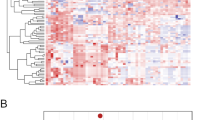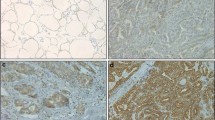Abstract
Purpose
Down-regulation of thyroid hormone receptor beta (THRβ) gene has been described in several human malignancies, including thyroid cancer. In this study, we analyzed THRβ mRNA expression in surgical specimens from a series of human papillary thyroid carcinomas (PTCs), characterized by their genotypic and clinical–biological features.
Methods
Thirty-six PTCs were divided into two groups according to the 2009 American Thyroid Association risk classification (17 low, 19 intermediate), and each group was divided into subgroups based on the presence or absence of the BRAFV600E mutation (21 BRAF mutated, 15 BRAF wild type). Gene expression was analyzed using fluidic cards containing probes and primers specific for the THRβ gene, as well as for genes of thyroperoxidase (TPO), sodium/iodide symporter (NIS), thyroglobulin (Tg) and thyroid stimulating hormone receptor (TSH-R) and for some miRNAs involved in thyroid neoplasia and targeting THRβ. The mRNA levels of each tumor tissue were compared with their correspondent normal counterpart.
Results
THRβ transcript was down-regulated in all PTCs examined. No significant differences were found between intermediate- vs low-risk PTCs patients, and BRAF-mutated vs BRAF wild-type groups. THRβ expression was directly correlated with NIS, TPO, Tg and TSH-R, and inversely correlated to miR-21, -146a, -181a and -221 expression.
Conclusions
Our results demonstrate that down-regulation of THRβ is a common feature of PTCs. While it is not associated with a more aggressive phenotype of PTC, it correlates with the reduction of all the markers of differentiation and is associated with overexpression of some miRNAs supposed to play a role in thyroid tumorigenesis.




Similar content being viewed by others
References
Cheng SY (2000) Multiple mechanisms for regulation of the transcriptional activity of thyroid hormone receptors. Rev Endocr Metab Disord 1:9–18
Kim WG, Cheng SY (2013) Thyroid hormone receptors and cancer. Biochim Biophys Acta 1830:3928–3936
Li Z, Meng ZH, Chandrasekaran R, Kuo WL, Collins CC, Gray JW, Diarkee SH (2002) Biallelic inactivation of the thyroid hormone receptor β1 gene in early stage breast cancer. Cancer Res 62:1939–1943
Ling Y, Xu X, Hao J, Ling X, Du X, Liu X, Zhao X (2010) Aberrant methylation of the THRB gene in tissue and plasma of breast cancer patients. Cancer Genet Cytogenet 196:140–145
Lin KH, Shieh HY, Chen SL, Hsu HC (1999) Expression of mutant thyroid hormone nuclear receptors in human hepatocellular carcinoma cells. Mol Carcinog 26:53–61
Futreal PA, Cochran C, Marks JR, Iglehart JD, Zimmerman W, Barret JC, Wiseman RW (1994) Mutation analysis of the THRA1 gene in breast cancer: deletion/fusion of the gene to a novel sequence on 17q in the BT474 cell line. Cancer Res 54:1791–1794
Dobrovic A, Houle B, Belouchi A, Bradley WE (1988) erbA-related genes coding for DNA-binding hormone receptors localized to chromosome 3p21-3p25 and deleted in small cell lung carcinoma. Cancer Res 48:682–685
Sisley K, Kurtis D, Rennie IG, Rees RC (1993) Loss of heterozygosity of the thyroid hormone receptor β in posterior uveal melanoma. Melanoma Res 3:457–461
Martinez-Iglesias O, Garcia-Silva S, Tenbaum SP, Regadera J, Larcher F, Paramio JM, Vennström B, Aranda A (2009) Thyroid hormone receptor β1 acts as a potent suppressor of tumor invasiveness and metastasis. Cancer Res 69(2):501–509
Kim WG, Zhu X, Kim DW, Zhang L, Kebebew E, Cheng SY (2013) Reactivation of the silenced thyroid hormone receptor β gene expression delays thyroid tumor progression. Endocrinology 154:25–35
Zhu XG, Zhao L, Willingham MC, Cheng SY (2010) Thyroid hormone receptors are tumor suppressors in a mouse model of metastatic follicular thyroid carcinoma. Oncogene 29:1909–1919
Lu J, Getz G, Miska EA, Alvarez-Saavedra E, Lamb J, Peck D, Sweet-Cordero A, Ebert BL, Mak RH, Fernando AA, Dowing JR, Jacks T, Horvitz HR, Golub TR (2005) MicroRNA expression profiles classify human cancers. Nature 435:834–838
Adams BD, Kasinski AL, Slack FJ (2014) Aberrant regulation and function of microRNAs in cancer. Curr Biol 24(16):R762–R776
Hayes J, Peruzzi PP, Lawler S (2014) MicroRNAs in cancer: biomarkers, functions and therapy. Trends Mol Med 20(8):460–469
Pallante P, Battista S, Pierantoni GM, Fusco A (2014) Deregulation of microRNA expression in thyroid neoplasias. Nat Rev Endocrinol 10:88–101
Dettmer MS, Perren A, Moch H, Komminoth P, Nikiforov YE, Nikiforova MN (2014) MicroRNA profile of poorly differentiated thyroid carcinomas–new diagnostic and prognostic insights. J Mol Endocrinol 52:181–189
Jazdzewski K, Boguslawska J, Jendrzejewski J, Liyanarachchi S, Pachucki J, Wardyn KA, Nauman A, De la Chapelle A (2011) Thyroid hormone receptor β (THRB) is a major target gene for microRNAs deregulated in papillary thyroid carcinoma (PTC). J Clin Endocrinol Metab 96:E546–E553
Edge SB, Compton CC (2010) The American Joint Committee on Cancer: the 7th edition of the AJCC cancer staging manual and the future of TNM. Ann Surg Oncol 17:1471–1474
Cooper DS, Doherty GM, Haugen BR, Kloos RT, Lee SL, Mandel SJ, Mazzaferri EL, McIver B, Pacini F, Schlumberger M, Sherman SI, Steward DL, Tuttle RM (2009) Revised American thyroid association management guidelines for patients with thyroid nodules and differentiated thyroid cancer. Thyroid 19:1167–1214
Sponziello M, Bruno R, Durante C, D’Agostino M, Corradino R, Giannasio P, Ciociola E, Ferretti E, Maranghi M, Verrienti A, De Toma G, Filetti S, Russo D (2011) Growth factor receptors gene expression and Akt phosphorylation in benign human thyroid nodules are unaffected by chronic thyrotropin suppression. Horm Metab Res 43:22–25
D’Agostino M, Sponziello M, Puppin C, Celano M, Maggisano V, Baldan F, Biffoni M, Bulotta S, Durante C, Filetti S, Damante G, Russo D (2014) Different expression of TSH receptor and NIS genes in thyroid cancer: role of epigenetics. J Mol Endocrinol 52:121–131
Sponziello M, Lavarone E, Pegolo E, Di Loreto C, Puppin C, Russo MA, Bruno R, Filetti S, Durante C, Russo D, Di Cristofano A, Damante G (2013) Molecular differences between human thyroid follicular adenoma and carcinoma revealed by analysis of a murine model of thyroid cancer. Endocrinology 154:3043–3053
Davies L, Welch HG (2014) Current thyroid cancer trends in the United States. JAMA Otolaryngol Head Neck Surg 140:317–322
Arturi F, Russo D, Giuffrida D, Schlumberger M, Filetti S (2000) Sodium-iodide symporter (NIS) gene expression in lymph-node metastases of papillary thyroid carcinomas. Eur J Endocrinol 143:623–627
Arturi F, Russo D, Bidart JM, Scarpelli D, Schlumberger M, Filetti S (2001) Expression pattern of the pendrin and sodium/iodide symporter genes in human thyroid carcinoma cell lines and human thyroid tumors. Eur J Endocrinol 145:129–135
Kogai T, Brent GA (2012) The sodium iodide symporter (NIS): regulation and approaches to targeting for cancer therapeutics. Pharmacol Ther 135:355–370
Schlumberger M, Lacroix L, Russo D, Filetti S, Bidart JM (2007) Defects in iodide metabolism in thyroid cancer and implications for the follow-up and treatment of patients. Nat Clin Pract Endocrinol Metab 3:260–269
Fagin JA, Mitsiades N (2008) Molecular pathology of thyroid cancer: diagnostic and clinical implications. Best Pract Res Clin Endocrinol Metab 22:955–969
Russo D, Damante G, Puxeddu E, Durante C, Filetti S (2011) Epigenetics of thyroid cancer and novel therapeutic targets. J Mol Endocrinol 46:R73–R81
Xing M (2013) Molecular pathogenesis and mechanisms of thyroid cancer. Nat Rev Cancer 13:184–199
Galrão AL, Sodré AK, Camargo RY, Friguglietti CU, Kulcsar MA, Lima EU, Medeiros-Neto G, Rubio IG (2013) Methylation levels of sodium-iodide symporter (NIS) promoter in benign and malignant thyroid tumors with reduced NIS expression. Endocrine 43:225–229
Puzianowska-Kuznicka M, Krystyniak A, Madej A, Cheng SY, Nauman J (2002) Functionally impaired TR mutants are present in thyroid papillary cancer. J Clin Endocrinol Metab 87(3):1120–1128
Ciampi R, Nikiforov YE (2005) Alterations of the BRAF gene in thyroid tumors. Endocr Pathol 16:163–172
Durante C, Puxeddu E, Ferretti E, Morisi R, Moretti S, Bruno R, Barbi F, Avenia N, Scipioni A, Verrienti A, Tosi E, Cavaliere A, Gulino A, Filetti S, Russo D (2007) BRAF mutations in papillary thyroid carcinomas inhibit genes involved in iodine metabolism. J Clin Endocrinol Metab 92(7):2840–2843
Puxeddu E, Durante C, Avenia N, Filetti S, Russo D (2008) Clinical implication of BRAF mutation in thyroid carcinoma. Trends Endocrinol Metab 19:138–145
Acknowledgments
This study was supported by the Fondazione Umberto Di Mario and by Banca d’Italia.
Conflict of interest
The authors declare that there is no conflict of interest that could be perceived as prejudicing the impartiality of the research reported.
Ethical approval
All procedures performed in this study involving human participants were in accordance with the ethical standards of the institutional and/or national research committee and with the 1964 Helsinki declaration and its later amendments or comparable ethical standards.
Informed consent
The authors declare that informed consent was obtained from all individual participants included in the study.
Author information
Authors and Affiliations
Corresponding author
Additional information
F. Rosignolo and V. Maggisano equally contributed to this work.
Electronic supplementary material
Below is the link to the electronic supplementary material.
40618_2015_309_MOESM1_ESM.ppt
Fig. S1 Correlation between miRNAs and thyroid-specific genes in human PTCs mRNA levels of TPO are significantly and inversely correlated to expression levels of miR-21 (a). mRNA levels of TG are significantly and inversely correlated to expression levels of miR-21 (b) and miR-146a (c). Correlations between miRNAs and thyroid-specific genes were analyzed by the Spearman rho rank correlation coefficient. Supplementary material 1 (PPT 248 kb)
Rights and permissions
About this article
Cite this article
Rosignolo, F., Maggisano, V., Sponziello, M. et al. Reduced expression of THRβ in papillary thyroid carcinomas: relationship with BRAF mutation, aggressiveness and miR expression. J Endocrinol Invest 38, 1283–1289 (2015). https://doi.org/10.1007/s40618-015-0309-4
Received:
Accepted:
Published:
Issue Date:
DOI: https://doi.org/10.1007/s40618-015-0309-4




